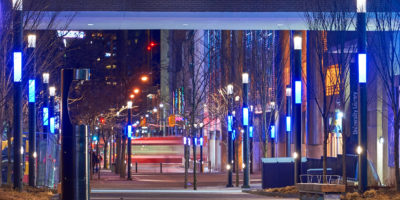By Allan Woods
Ryerson student Allen Ho’s death at a rave in October will be the focus of an upcoming coroner’s inquest.
Last Thursday’s announcement by the coroner’s office was only the latest example of growing scrutiny of the rave scene.
The attention intensified after two teenagers were arrested at Pearson Airport Friday carrying $1.2 million in ecstasy and four people overdosed at two separate raves early Sunday morning.
The inquest, scheduled for late spring, will look into the dangers of ecstasy, as well as venues security measures and emergency resources at raves, said deputy chief coroner Bonita Porter.
“We felt that the circumstances that led up to [Ho’s] death were most representative of the problems with the drug and the rave parties,” Porter said.
The 21-year-old business student’s death was among the most publicized of nine rave fatalities in Ontario last year. Since then, city and police officials have taken steps to regulate the parties. Toronto police have formed a rave party task force that includes police, fire, ambulance and city officials. It will present recommendations to police Chief David Boothby in about a month.
City council has also taken steps to make raves safer. The Toronto Dance Safety Committee, along with promoters and security companies, prepared a bylaw dealing specifically with raves.
The bylaw, passed unanimously by council Dec. 15, defined a rave as “a public, all-ages, commercial, electronic music event held in a special venue, past 5 a.m., attended by mostly paying customers.” It also sets fire codes, health and zoning standards, maximum occupancy limits and security requirements.
Sean Parsons, owner of High Profile Events Security Inc., said his security team has handled between 15,000 and 20,000 raves at places such as The Docks, the CNE and the Metro Convention Centre.
He said the Liquid Lounge party at Dufferin Street near Finch Avenue, where three men overdosed early Sunday morning, exceeded capacity and did not have enough policy or ambulances on hand.
“With five or six or 7,000 people in a venue like the Metro Convention Centre, proper security can catch anything,” Parsons said. “In an overcrowded rave—even with enough security—it can take as long as 25 minutes to get from one end to the other. We can’t catch the drug dealers in there. We can’t find the person who is passed out.”
With the increased attention on raves, promoters like Tyler Cho, co-owner of Life Force Industries, aren’t taking chances.
“My biggest concern right now is safety,” Cho said. “It’s not good to have incidents like [overdoses] on the scene.”
Cho has been involved in the rave scene for seven years and said two or three years ago a large party would have had between 2,000 and 3,000 people. “Now 10,000 is a big party,” he said.
Parsons said police realize Toronto’s rave scene is one of the largest in North America and that’s why they have been working with the rave community rather than attempting to ban raves outright.
“We’re not trying to stop raves from happening,” said rave task force spokesman Sergeant Nigel Fontaine. “It is not for us to pass moral or social judgement.” As raves become more mainstream—at venues such as as System Soundbar, Jet, Limelight and Guvernment—clubs are opening their doors to an all-ages crowd from 2 a.m. until about 6 a.m.
As the clubs accept more ravers, they also contend with more drug problems.
In the past year, the Guvernment had 44 overdose incidents in which ambulances had to be called, Parsons said. But the bylaw governing raves does not apply to clubs, so there’s no police presence inside.
Parsons said the inquest into Ho’s death will probably result in an initiative allowing the police to go after club owners. “The police haven’t got much teeth now,” Parsons said. “But once they start working with people in the rave community they’ll be able to control it.”









Leave a Reply